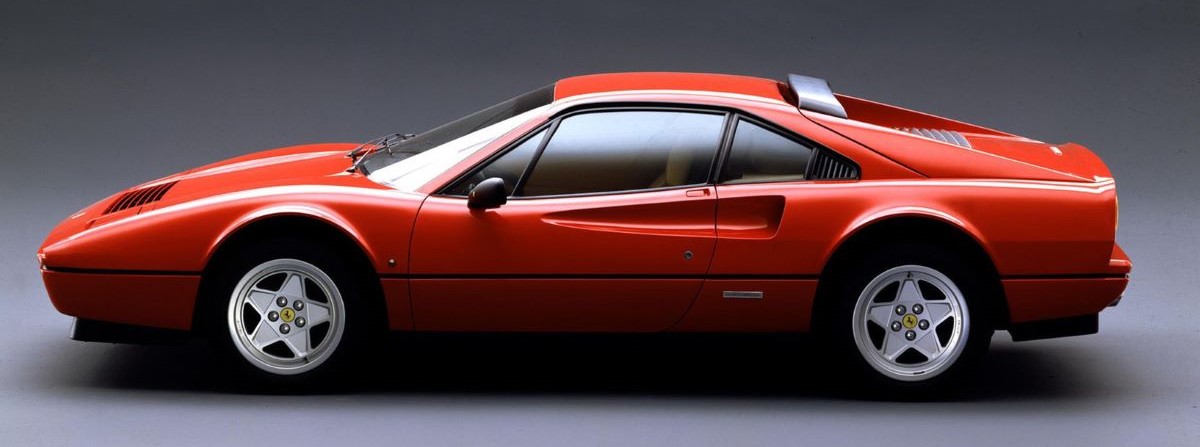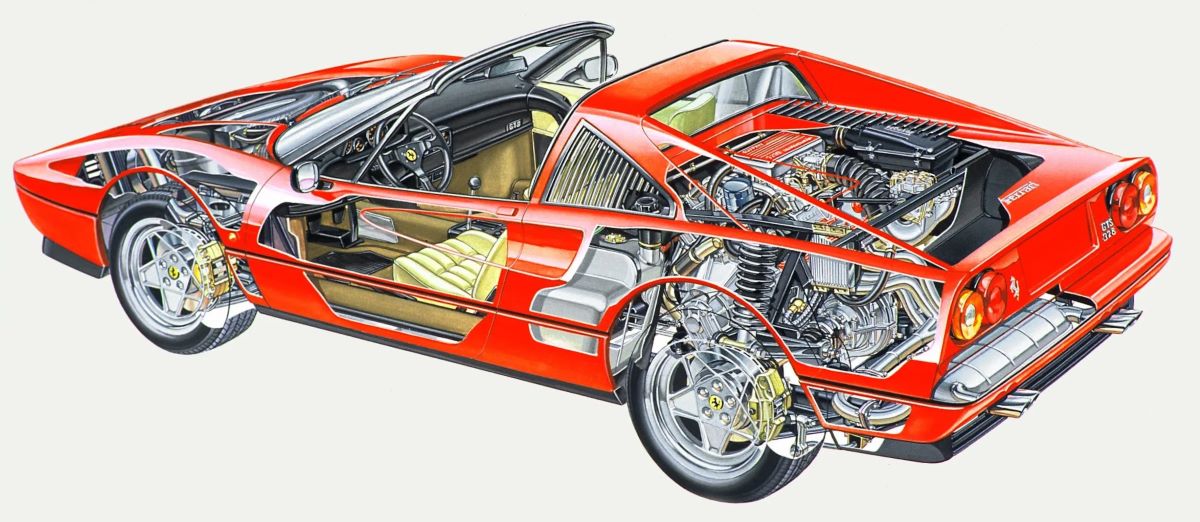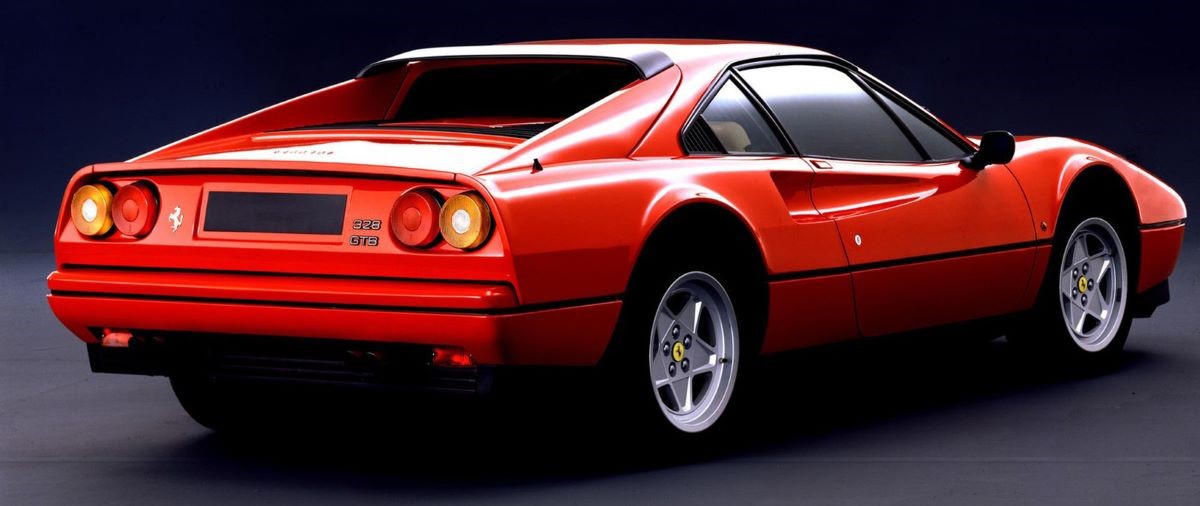
328 GTB
The 308 series had won universal acclaim from both customers and critics, and its natural evolution continued with the 328 GTB, a berlinetta fitted with the new 3.2-litre version of the V8. This new engine (again featuring four valves per cylinder) produced a specific output of 85 bhp per litre, compared with 82 for the 4-valve version of the 308. Pininfarina’s original design, which was still both attractive and elegant, was revised to further improve the aerodynamic characteristics of the 308 models.
The 328 GTB model, together with the targa roof 328 GTS variant, were the final developments of the normally aspirated transverse V8 engine 2 seat series. The 328 figures in the model title referred to the total cubic capacity of the engine, 3.2 litres, and 8 for the number of cylinders. The new model was introduced at the 1985 Frankfurt Salon alongside the Mondial 3.2 series.
Essentially the new model was a revised and updated version of the 308 GTB, which had survived for almost a decade without any radical change to the overall shape, albeit with various changes to the 3 litre engine. The 328 model presented a softening of the wedge profile of its predecessor, with a redesigned nose that had a more rounded shape, which was complimented by similar treatment to the tail valance panel. The revised nose and tail sections featured body colour bumpers integral with the valance panels, which reflected the work done concurrently to present the Mondial 3.2 models, with which they also shared a similar radiator grille and front light assembly layout. Thus all the eight cylinder cars in the range shared fairly unified front and rear aspects, providing a homogeneous family image. The exhaust air louvres behind the retractable headlight pods on the 308 series disappeared, coupled with an increase in the size of the front lid radiator exhaust air louvre, which had been introduced on the 308 Quattrovalvole models, whilst a new style and position of exterior door catch was also provided. The interior trim also had a thorough overhaul, with new designs for the seat panel upholstery and stitching, revised door panels and pulls, together with more modern switchgear, which complimented the external updating details. Optional equipment available was air conditioning, metallic paint, Pirelli P7 tyres, a leather dashboard, leather headlining plus rear window surround and a rear aerofoil (standard on Japanese market models).
In the middle of 1988 ABS brakes were made available as an option, which necessitated a redesign of the suspension geometry to provide negative offset. This in turn meant that the road wheel design was changed to accommodate this feature. The original flat spoke “star” wheels became a convex design, in the style as fitted to the 3.2 Mondial models, whether ABS was fitted or not.
The main European market 328 GTB models had a tubular chassis with a factory type reference F 106 MB 100. Disc brakes, with independent suspension via wishbones, coil springs, and hydraulic shock absorbers, were provided all round, with front and rear anti roll bars. There were various world market models, each having slight differences, with right and left hand drive available.
The V8 engine was essentially of the same design as that used in the 308 Quattrovalvole model, with an increase in capacity to 3185cc, with a bore and stroke of 83mm x 73mm, and a type reference number F 105 CB 000. The engine retained the Bosch K-Jetronic fuel injection system of its predecessor, but was fitted with a Marelli MED 806 A electronic ignition system, to produce a claimed power output of 270bhp at 7000rpm. As with the preceding 308 models the engine was mounted in unit with the all synchromesh five speed transmission assembly, which was below, and to the rear of the engine’s sump.
The 328 GTB continued in production for four years, until replaced by the 348 tb model in the Autumn of 1989, during which time 1344 examples were produced in the chassis number range of 58735 to 83017. The early part of the series was numbered in the Ferrari odd number road car chassis sequence, and later examples (post chassis number 75000) in the continuous number sequence.

328 GTS
Pininfarina paid particular attention to styling details that influenced the car’s CD and aerodynamic lift characteristics – with impressive results. Cabin ergonomics were improved and the shape of the seats revised to better suit the sporty driving style this type of car deserved. On all versions, low profile tyres and 16″ alloy wheels were available as an option.
The 328 GTS model, together with the fixed roof 328 GTB, were the final developments of the normally aspirated transverse V8 engine 2 seat series. The 328 figures in the model title referred to the total cubic capacity of the engine, 3.2 litres, and 8 for the number of cylinders. The new model was introduced at the 1985 Frankfurt Salon alongside the Mondial 3.2 series.
Essentially the new model was a revised and updated version of the 308 GTS, which had survived for eight years without any radical change to the overall shape, albeit with various changes to the 3 litre engine. The 328 model presented a softening of the wedge profile of its predecessor, with a redesigned nose that had a more rounded shape, which was complimented by similar treatment to the tail valance panel. The revised nose and tail sections featured body colour bumpers integral with the valance panels, which reflected the work done concurrently to present the Mondial 3.2 models, with which they also shared a similar radiator grille and front light assembly layout. Thus all the eight cylinder cars in the range shared fairly unified front and rear aspects, providing a homogeneous family image. The exhaust air louvres behind the retractable headlight pods on the 308 series disappeared, coupled with an increase in the size of the front lid radiator exhaust air louvre, which had been introduced on the 308 Quattrovalvole models, whilst a new style and position of exterior door catch was also provided. The interior trim also had a thorough overhaul, with new designs for the seat panel upholstery and stitching, revised door panels and pulls, together with more modern switchgear, which complimented the external updating details. Optional equipment available was air conditioning, metallic paint, Pirelli P7 tyres, a leather dashboard, leather headlining to the removable roof panel plus rear window surround, and a rear aerofoil (standard on Japanese market models).
In the middle of 1988 ABS brakes were made available as an option, which necessitated a redesign of the suspension geometry to provide negative offset. This in turn meant that the road wheel design was changed to accommodate this feature. The original flat spoke “star” wheels became a convex design, in the style as fitted to the 3.2 Mondial models, whether ABS was fitted or not.
The main European market 328 GTS models had a tubular chassis with a factory type reference F 106 MS 100. Disc brakes, with independent suspension via wishbones, coil springs, and hydraulic shock absorbers, were provided all round, with front and rear anti roll bars. There were various world market models, each having slight differences, with right and left hand drive available.
The V8 engine was essentially of the same design as that used in the 308 Quattrovalvole model, with an increase in capacity to 3185cc, with a bore and stroke of 83mm x 73mm, and a type reference number F 105 CB 000. The engine retained the Bosch K-Jetronic fuel injection system of its predecessor, but was fitted with a Marelli MED 806 A electronic ignition system, to produce a claimed power output of 270bhp at 7000rpm. As with the preceding 308 models the engine was mounted in unit with the all synchromesh five speed transmission assembly, which was below, and to the rear of the engine’s sump.
The 328 GTS continued in production for four years, until replaced by the 348 ts model in the Autumn of 1989, during which time 6068 examples were produced in the chassis number range of 59301 to 83136, the GTS production outnumbering the GTB version almost five to one. The early part of the series was numbered in the Ferrari odd number road car chassis sequence, and later examples (post chassis number 75000) in the continuous number sequence.

Specifications and Features
Engine
Type………………………………rear, transverse, 90° V8
Bore/stroke……………………83 x 73.6 mm
Unitary displacement……….398,22 cc
Total displacement…………..3185.76 cc
Compression ratio……………9.8 : 1
Maximum power……………..199 kW (270 hp) at 7000 rpm
Power per litre…………………85 hp/l
Maximum torque…………….304 Nm (31 kgm) at 5500 rpm
Valve actuation………………..twin overhead camshafts per bank, four valves per cylinder
Fuel feed………………………..Bosch K-Jetronic mechanical injection
Ignition………………………….Marelli Microplex electronic, single spark plug per cylinder
Lubrication…………………….wet sump
Clutch……………………………single-plate
Chassis
Frametubular steel
Front/Rear suspension…….independent, unequal-length wishbones, coil springs over telescopic shock absorbers, anti-roll bar
Brakes……………………………discs
Transmission………………….5-speed + reverse
Steering…………………………rack-and-pinion
Fuel tank………………………..capacity 74 litres
Front tyres……………………..205/55 VR 16
Rear tyres………………………225/50 VR 16
Bodywork
- Type…………………………….two-seater berlinetta or two-seater targa-top
- Length…………………………4255 mm
- Width………………………….1730 mm
- Height…………………………1128 mm
- Wheelbase……………………2350 mm
- Front track…………………..1485 mm
- Rear track…………………….1465 mm
- Weight………………………….1263 kg (dry) berlinetta / 1273 kg (dry) targa-top
Performance
- Top speed………………………263 km/h
- Acceleration
0-100 km/h……………………..6.4 sec
0-400 m…………………………14.3 sec
0-1000 m……………………….25.7 sec



You must be logged in to post a comment.